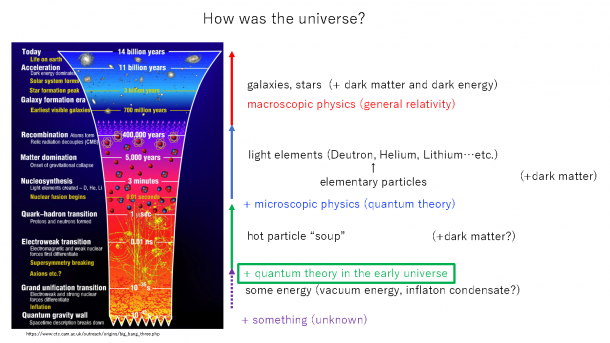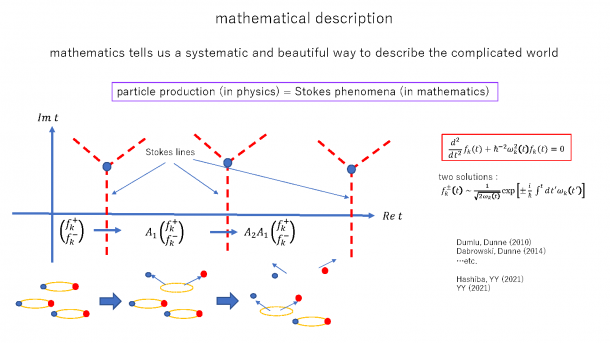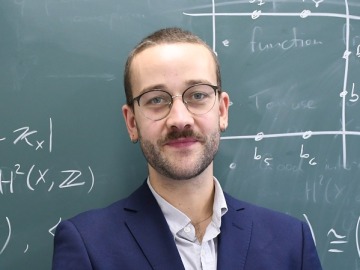
YAMADA Yusuke, Assistant Professor
Searching for a method to systematically describe the process of particle creation
Around 13.8 billion years ago, the visible universe was a tiny, point-like area. It was a dense and very hot ball of energy, but it caused an extremely violent, accelerated expansion (called “inflation”), eventually forming a hot, dense, fireball-like universe. This fireball universe expanded (the Big Bang), resulting in lower temperatures and the formation of stars and galaxies—becoming the universe in its present form.
The subject of my research is extremely early in the universe’s lifetime: immediately after inflation but before the Big Bang. I am investigating how particles came into our world and how they then acted to form the universe (Diagram 1). Since we deal with the microscopic world of particle creation, I will utilize quantum theory (quantum mechanics), but one must simultaneously consider the expansion’s gravitational effects. Therefore, one must combine quantum theory with general relativity as a theory of gravity, yet a systematic method describing the result of this combination has not been established.
I’ve wanted to create an “ultimate theory” describing the universe since my university days, so currently I’m working on the first step: establishing a theory accurately describing the process of particle creation.

Diagram 1: A chronology of the universe’s formation. The purple dotted line is the area of my research. In describing the earliest moments of the universe, one must combine quantum theory and general relativity.
Two explanations of particle production: “production from a vacuum” and “inflaton collapse”
It is thought that after inflation occurred, particles were produced within a universe brimming with vacuum energy as expansion continued, but there are two explanations of the production method.
The first is “production from a vacuum”. In the visible, macroscopic world, a vacuum refers to emptiness, but in the invisible, microscopic world governed by quantum theory, it is thought that the vacuum was packed with pairs of virtual particles and antiparticles. They eliminated each other through pair annihilation, preserving a state of nothingness, but they could be excited by external forces like expansion, pulling them apart and forming pairs of real particles and antiparticles.
The second is “inflaton collapse”, currently the leading explanation. It posits that the clump of energy that caused inflation—known as an inflaton field—collapsed into lighter particles. Through E=mc2 from Einstein’s Theory of Relativity (“E” is energy, “m” is mass, “c” is the speed of light), we can see that the energy of the inflaton field is a clump of heavy particles, so they can collapse into lighter particles.
Thinking of particle production as a Stokes phenomenon from mathematics
However, currently there are no descriptions that explain these particle production phenomena in a systematic way. Here, I noticed it is possible to consider the physical particle production phenomena as a Stokes phenomenon from mathematics. The Stokes phenomenon is when a solution (behavior) jumps discontinuously when singularities are crossed (Diagram 2).

Diagram 2: The X axis shows the actual time, the Y axis shows the time in imaginary numbers, and the red dashed line shows the Stokes line. The Stokes line is viewed as a singularity (excluded as undefined). fk+ and fk– are analytical solutions to differential equations. Ax is a 2×2 matrix. By crossing the Stokes line, Ax is multiplied, mixing the solutions.
The X axis shows the actual time. By crossing the Stokes line from left to right, the solution on the right becomes the product of the solution on the left and Ax (a 2×2 matrix). In other words, with the Stokes line in between them, the left and right solutions mix, becoming physically different. This means that where it looks as if there was nothing on the left, there seem to be particles on the right—which can be seen as expressing production and annihilation. One can also view particle decay and scattering similarly.
A simpler way to put it: where the solution jumps crossing the Stokes line, particles also physically “jump” and are produced.
Though there are precedents to seeing particle production phenomena in electromagnetic fields as Stokes phenomena, in terms of research explaining the universe’s particle production phenomena as Stokes phenomena, I am one of the pioneers. To reconstruct the particle production process, I am seeking a method to solve this equation just as one uses factorization to solve the quadratic equation.
It may turn out that the particle production process is more complex. For example, particles born in a vacuum can decay into lighter particles. To consider such processes, quantum theories accounting for external forces like cosmic expansion are needed, but unsolved problems abound in the absence of a systematic theory. To solve these problems, I wish to enhance quantum theories that include expansion’s effects, then to solve the riddle of the universe’s creation: how particles were born into our world and formed the universe.
Coverage/Constitution: AIMONO Keiko
Cooperation: Graduate School of Political Science, Waseda University, J-School










